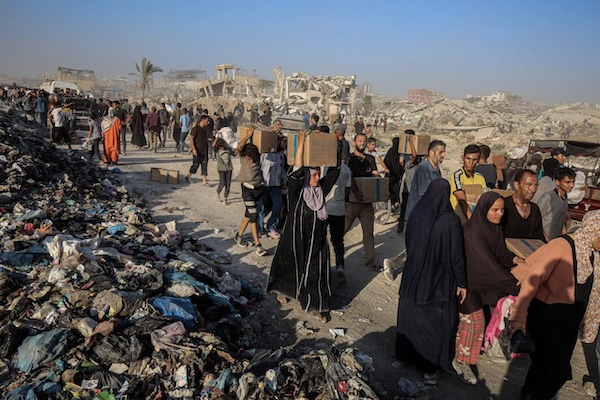These days, in Gaza, over 100 people are killed by Israeli forces every single day. Not all of them die in tents–many are indiscriminately targeted while trying to reach food at so-called “aid” sites run by the Gaza Humanitarian Foundation (GHF), the Israeli-backed and American-run company that has replaced the UN’s aid system in the Strip.
Since March 1, Israel has imposed a total blockade on Gaza, preventing all humanitarian aid from entering the coastal enclave. Between March and May 19, not a single aid truck was allowed through. When shipments resumed, they were severely restricted, and many were intercepted or looted by Israeli-backed gangs before reaching warehouses. The GHF “aid” sites, touted as a humanitarian initiative, have turned food distribution into sadistic “death traps,” as Palestinian aid-seekers have described them in countless testimonies.
Palestinians have been saying this for months, describing how the Israeli army opens fire on aid-seekers, even after they are ordered to enter; how they are corralled into narrow, fenced corridors like cattle and made to fight over food boxes in a scene of deliberate and engineered chaos. But the testimonies have largely fallen on deaf ears, despite the fact that over 500 people have been killed and hundreds more have been wounded near these sites. The fact that the United Nations and numerous other humanitarian groups have refused to cooperate with the GHF, citing violations of neutrality and basic humanitarian standards–and calling the GHF plan a “blueprint for ethnic cleansing”–barely made a dent in the public eye.
“This U.S.-supported aid operation is inherently unsafe,” said UN Secretary-General António Guterres.
It’s killing people.
Then, Haaretz broke a story in late June highlighting firsthand testimonies from Israeli soldiers that corroborated what Palestinians had been saying for weeks: the soldiers were given explicit orders to shoot unarmed civilians at GHF aid sites. Massacres were not accidents, but directives.
In this, Haaretz didn’t uncover new facts–it just repeated what we’ve already been screaming into the void. But because the words came from Israeli mouths, they were taken seriously.
The report sparked immediate global attention. Reuters, AP, and AFP published follow-up reports, and even Israeli Prime Minister Benjamin Netanyahu and Defense Minister Israel Katz were forced to condemn the report as a “blood libel.”
Our suffering was validated only after our oppressors admitted it. We posted the footage first. We shared the testimonies first. We livestreamed our grief first. But no one believed us.
The killing fields are still being ignored
Before the advent of the GHF and Israel’s recently intensified starvation policy in Gaza, aid distribution was conducted through 400 UN-run centers. The system was simple and efficient: families received SMS notifications with pickup times, and food was distributed within an hour.
The GHF sites, in contrast, are militarized zones with no oversight where aid-seekers are herded into glorified cages, hoping to reach food before the gates close–or before soldiers open fire. Distribution times are announced unpredictably through a Facebook page, sometimes with only five or ten minutes’ notice. One day, the gates open at 8 a.m., another at midnight–or not at all.
“I had to go there multiple times to bring food home,” said 18-year-old Naji Hamad, who stands under the sun almost 10 hours a day to sell 200 packets of iced water to feed his family.
We have no white flour, no beans, not even lentils. Everything is sold at insane prices.
The GHF site closest to Hamad is near the Netzarim corridor, around two kilometers from his shelter. It takes him about 30 minutes on foot to get there. On some nights, he sleeps near the entrance, hoping to be the first in line. But even that doesn’t guarantee access.
“The last time I went, I swore I wouldn’t go again,” he said.
It was chaos. I thought I’d die. I found myself on the ground. Everyone was running, pushing, trying to grab food. I returned home empty-handed.
Even for those who do manage to secure a food parcel, the danger is not over. “Sometimes men with knives wait outside,” Hamad explained.
They’ll threaten you. If you resist, they’ll beat you or worse. I’ve seen it happen.
The entire ordeal depends on luck. If you’re lucky, you get a food package and dodge the looters. If not, you scrape a handful of spilled pasta or lentils off the ground, pack it into a bag, and take it home, hoping to clean it and feed your family. But the violence doesn’t end there. Israeli soldiers and tanks are stationed just meters from the aid sites, rifles aimed at the crowd. Without warning, bullets fly, gas canisters explode, and panic erupts.
Naji Hamad’s story is one among many, as survivors have been pouring out their stories for weeks. Graphic footage has spread across social media. But none of it mattered–no one was listening.
Days after Haaretz broke its story about the “killing fields” of the GHF, the Associated Press published another bombshell: American mercenaries, contracted through private military firms, were also involved in the shootings near GHF sites. The report, based on leaked internal communications, eyewitness accounts, and video evidence confirmed that U.S. nationals had joined Israeli forces in targeting civilians.
GHF’s response was flat denial, dismissing the story as misinformation–just as they’ve done with every video, testimony, and live broadcast from Gaza.
And yet, I don’t care anymore about the exposés. I don’t care whether a newspaper finally sympathizes, or whether another investigation confirms what we’ve known for months. I only care about the result.
I care that nothing has changed. The death toll hasn’t dropped. Aid hasn’t increased. “Firebelts” and drone hums are still echoing through my child’s ears after more than 600 days of war.
Meanwhile, Israel continues killing over 100 Gazans a day–some in aid lines, others in shelters, and most of them in silence.

